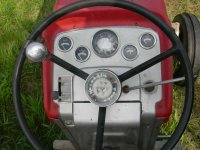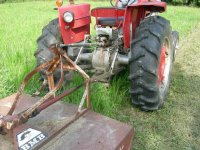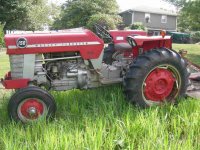Farmwithjunk
Super Member
FWJ, Are you sure your not getting a commission off this deal?
With a post and offer like that...I'd be on the phone saying DEAL!!
Rob
No commission, but I'd be in the truck and on my way to get that tractor if it was closer to home! I've owned all sorts of tractors. Even have a few new ones. BUt given the choice, I'd be able to live with just one. The 150 is well balanced, economic to operate, reliable, simple design that's a breeze to take care of, and pound for pound/dollar for dollar, the best tractor I've ever had the pleasure of operating.
Here's a brief list of things to look at when shopping for a 150;
Check front end/steering. 150's came standard with power steering. It was different than the 135. The 150 used essentially the same steering components as the heavier/more powerful 165. Check to see if it steers side to side equally. SOMETIMES a simple adjustable clevis and pin in the steering mechanism can wear, causing right to left steering to be MUCH different than left to right. Re-adjustment usually corrects that issue. Front axle center pivot will wear, especially if the tractor has had a loader at any point in its life. Tie rods wear, causing play in the steering. Simple replacement if that's an issue.
Oil leak(s) Under the bellhousing and transmission, you'll find a pair of weep holes. You SHOULD be able to see the open ends of cotter pins sticking out. The pins are there to prevent dirt from closing off the weep holes. Oil dripping from either hole COULD be a bad sign. An occasional drop isn't anything to be concerned about. Excessive dripping is. The Perkins engines tended to leak at the rear of the oil pan. 99 time in 100 that's what causes engine oil to show up. The Continental engine didn't have that issue. Engine oil there MAY come from a leaky rear main seal. VERY rare though. Transmission/hydraulic oil can be from the front seal in the tranny. MultiPower equipped tractors showing hydraulic oil MAY be more serious. At any rate, transmission oil dripping is a res flag.
Rear lift; Make certain the 3-point hitch will raise significant weight, (Most any 3-point mounted implement will do) It's not UNcommon when the lift will drift back down once the tractor is shut off. The 3-point controls have TWO levers. The one nearest to the seat is the POSITION CONTROL. Use it for MOST 3-point functions. The furthest from the seat (round knob) is the DRAF CONTROL lever. Use it with plows, ect, when you want draft control function. When using EITHER, leave the OTHER one in the raised position.
ALL 150's were live power. SOME MultiPower equipped models were independent pto. The rest were 2-stage clutch.
Last edited:




